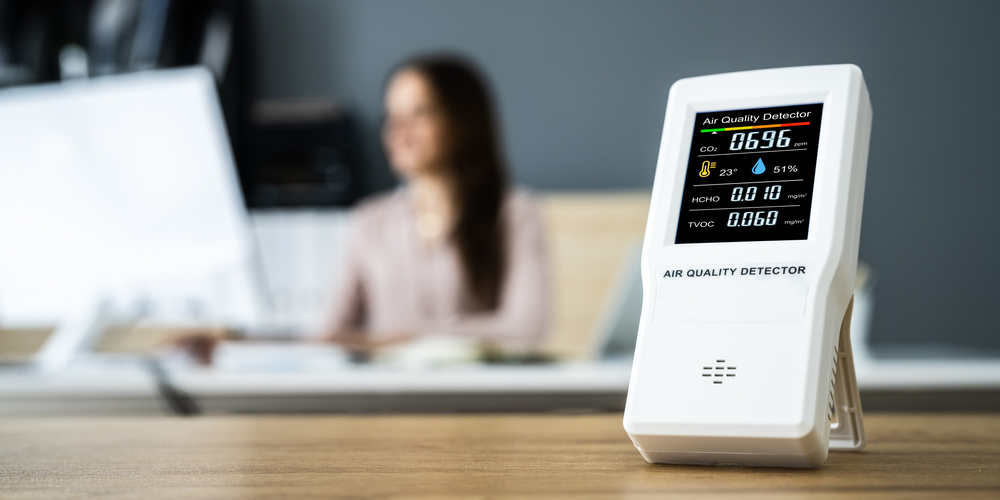What to Do With Your Indoor Air Quality (IAQ) Data
Indoor air quality (IAQ) data provides valuable insights into the quality of the air within a building, which can have a significant impact on the health, comfort, and productivity of occupants. But it can be hard to translate the data into insights that will make a difference.
This article will run through some of the ways IAQ data can help you manage your building.
How to collect IAQ data
If your building is not equipped with sensors and other data collection devices, you can hire an indoor air quality professional (like ours) to conduct an assessment of your building's air quality. They will use specialised equipment to measure levels of pollutants such as carbon dioxide (CO2), particulate matter (PMx) and volatile organic compounds (VOCs) as well as temperature and humidity for indoor environmental quality (IEQ) levels.
The most useful way to obtain long-term data is through regular monitoring, which is why it’s recommended to install various sensors and monitoring systems that can link up to your building management system (BMS). However, any data collection is better than no data at all.
Once you have your IAQ data, it can be used in several ways to improve indoor environments and overall well-being.
Occupant health and comfort
IAQ data can help identify potential health risks associated with poor air quality, such as respiratory issues, allergies and other health concerns.
Monitoring data allows building managers to take prompt action in response to poor IAQ, reducing the likelihood of health issues among occupants. Proper ventilation and control of pollutants based on IAQ data can contribute to a more comfortable and productive environment.
Ventilation optimisation
CO2 levels are often used as an indicator of ventilation effectiveness. IAQ data will usually include CO2 levels, and can help let you know when to fine-tune ventilation systems to ensure an adequate supply of fresh air and prevent stuffy or stale air conditions.
Pollution source identification
IAQ data can help identify the sources of indoor pollutants. By analysing pollutant levels and correlating them with activities or events, you can pinpoint potential pollution sources and take corrective actions.
HVAC system performance
Monitoring IAQ data can provide insights into the performance of HVAC systems. If your IAQ deteriorates despite proper ventilation, it could indicate issues with filters, coils or other system components that need maintenance. Our MaintainAway solution remotely monitors all the key components of an HVAC system so you can remediate only what is necessary, without wasting energy and time on other components and disparate areas of the building.
Energy efficiency
IAQ data can be used to optimise energy consumption. By adjusting ventilation rates based on occupancy and indoor air quality, energy waste due to over-ventilation can be minimised.
Learn more about energy efficiency in our article on how to save energy in your workplace.
Compliance and certifications
For commercial buildings, IAQ data can be crucial for demonstrating compliance with regulations and certifications related to indoor environmental quality, such as LEED (Leadership in Energy and Environmental Design) and AirRated.
Building management systems (BMS) integrations
You can integrate IAQ data collection and analysis into building management systems. It enables real-time monitoring and control of HVAC systems based on IAQ conditions. Instant alerts from sensors can help building managers identify areas that require improvement and take necessary actions to maintain healthy indoor air quality.
This can lead to improved occupant comfort and productivity, avoids costly repairs and maintenance down the line, while the higher reaction speed helps stay compliant.
Alerts and notifications
IAQ data systems can trigger alerts and notifications to building managers when certain thresholds are exceeded, allowing for a quick response to potential IAQ issues. For example, a high concentration of CO2 in one part of an office could indicate a malfunction in the ventilation. Alerts can be easily configured in an IAQ analytics platform.
Long-term trend analysis
By collecting IAQ data over time, trends in air quality can be identified. This information can guide long-term planning and improvements to building design and operations.
For example, if IAQ data shows that CO2 levels consistently rise during certain times of day, building managers may need to adjust ventilation settings or schedule more frequent air filter replacements. Similarly, if humidity levels are consistently high in certain areas of the building, building managers may need to address moisture issues or adjust HVAC settings.
Occupant education and engagement
Sharing IAQ data with building occupants can raise awareness about indoor air quality and encourage behaviours that contribute to better air quality, such as proper ventilation and avoiding pollutant sources.
IAQ data can be displayed on building performance dashboards to provide occupants with real-time feedback on indoor air quality and promote behaviour change. They can also be used to display energy consumption data and other sustainability metrics.
Research and studies
Your IAQ data can go further than your building, helping the industry and government improve air quality guidelines. Aggregated IAQ data can contribute to scientific research and studies that aim to understand the relationship between indoor air quality, human health and building design.
IAQ data is a valuable tool for understanding and improving the quality of indoor environments. Properly utilising IAQ data can lead to healthier, more comfortable spaces, increased energy efficiency, and better overall building performance.
Our IAQ specialists are always on hand to answer any questions you may have about IAQ data collection and assessment. Get in touch for a chat.






